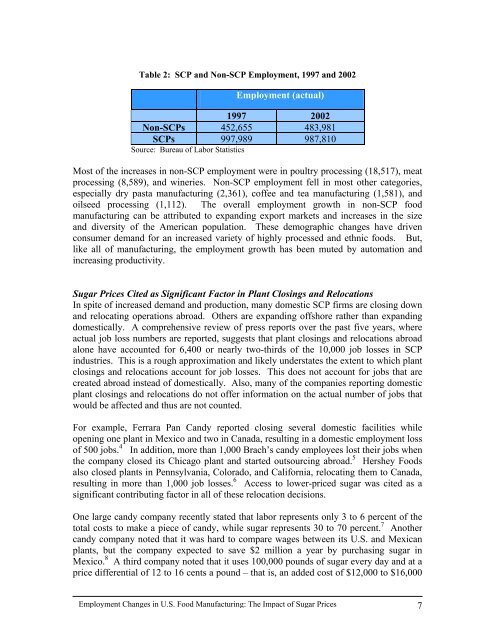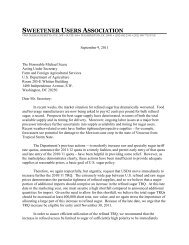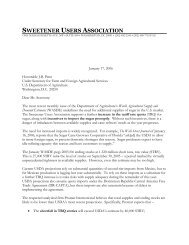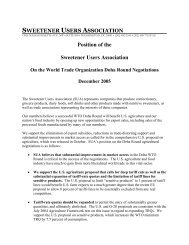Employment Changes in US Food Manufacturing - Coalition for ...
Employment Changes in US Food Manufacturing - Coalition for ...
Employment Changes in US Food Manufacturing - Coalition for ...
Create successful ePaper yourself
Turn your PDF publications into a flip-book with our unique Google optimized e-Paper software.
Table 2: SCP and Non-SCP <strong>Employment</strong>, 1997 and 2002<br />
<strong>Employment</strong> (actual)<br />
1997 2002<br />
Non-SCPs 452,655 483,981<br />
SCPs 997,989 987,810<br />
Source: Bureau of Labor Statistics<br />
Most of the <strong>in</strong>creases <strong>in</strong> non-SCP employment were <strong>in</strong> poultry process<strong>in</strong>g (18,517), meat<br />
process<strong>in</strong>g (8,589), and w<strong>in</strong>eries. Non-SCP employment fell <strong>in</strong> most other categories,<br />
especially dry pasta manufactur<strong>in</strong>g (2,361), coffee and tea manufactur<strong>in</strong>g (1,581), and<br />
oilseed process<strong>in</strong>g (1,112). The overall employment growth <strong>in</strong> non-SCP food<br />
manufactur<strong>in</strong>g can be attributed to expand<strong>in</strong>g export markets and <strong>in</strong>creases <strong>in</strong> the size<br />
and diversity of the American population. These demographic changes have driven<br />
consumer demand <strong>for</strong> an <strong>in</strong>creased variety of highly processed and ethnic foods. But,<br />
like all of manufactur<strong>in</strong>g, the employment growth has been muted by automation and<br />
<strong>in</strong>creas<strong>in</strong>g productivity.<br />
Sugar Prices Cited as Significant Factor <strong>in</strong> Plant Clos<strong>in</strong>gs and Relocations<br />
In spite of <strong>in</strong>creased demand and production, many domestic SCP firms are clos<strong>in</strong>g down<br />
and relocat<strong>in</strong>g operations abroad. Others are expand<strong>in</strong>g offshore rather than expand<strong>in</strong>g<br />
domestically. A comprehensive review of press reports over the past five years, where<br />
actual job loss numbers are reported, suggests that plant clos<strong>in</strong>gs and relocations abroad<br />
alone have accounted <strong>for</strong> 6,400 or nearly two-thirds of the 10,000 job losses <strong>in</strong> SCP<br />
<strong>in</strong>dustries. This is a rough approximation and likely understates the extent to which plant<br />
clos<strong>in</strong>gs and relocations account <strong>for</strong> job losses. This does not account <strong>for</strong> jobs that are<br />
created abroad <strong>in</strong>stead of domestically. Also, many of the companies report<strong>in</strong>g domestic<br />
plant clos<strong>in</strong>gs and relocations do not offer <strong>in</strong><strong>for</strong>mation on the actual number of jobs that<br />
would be affected and thus are not counted.<br />
For example, Ferrara Pan Candy reported clos<strong>in</strong>g several domestic facilities while<br />
open<strong>in</strong>g one plant <strong>in</strong> Mexico and two <strong>in</strong> Canada, result<strong>in</strong>g <strong>in</strong> a domestic employment loss<br />
of 500 jobs. 4 In addition, more than 1,000 Brach’s candy employees lost their jobs when<br />
the company closed its Chicago plant and started outsourc<strong>in</strong>g abroad. 5 Hershey <strong>Food</strong>s<br />
also closed plants <strong>in</strong> Pennsylvania, Colorado, and Cali<strong>for</strong>nia, relocat<strong>in</strong>g them to Canada,<br />
result<strong>in</strong>g <strong>in</strong> more than 1,000 job losses. 6 Access to lower-priced sugar was cited as a<br />
significant contribut<strong>in</strong>g factor <strong>in</strong> all of these relocation decisions.<br />
One large candy company recently stated that labor represents only 3 to 6 percent of the<br />
total costs to make a piece of candy, while sugar represents 30 to 70 percent. 7 Another<br />
candy company noted that it was hard to compare wages between its U.S. and Mexican<br />
plants, but the company expected to save $2 million a year by purchas<strong>in</strong>g sugar <strong>in</strong><br />
Mexico. 8 A third company noted that it uses 100,000 pounds of sugar every day and at a<br />
price differential of 12 to 16 cents a pound – that is, an added cost of $12,000 to $16,000<br />
<strong>Employment</strong> <strong>Changes</strong> <strong>in</strong> U.S. <strong>Food</strong> Manufactur<strong>in</strong>g: The Impact of Sugar Prices 7













